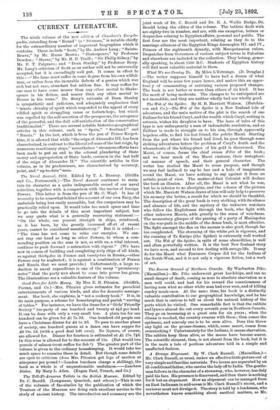The Web of the Spider. By H. B. Marriott Watson.
(Hutchin- son and Co.)—The Web of the Spider is a New Zealand tale of adventure, and the main motive of the plot is the search of one Palliser for his friend Caryl, and the wealth which Caryl, writing in extremis, wishes his daughter to have. The hero of tales of this type is not unfrequently a man of indomitable resolution, and so Palliser is made to struggle on to his aim, through apparently hopeless odds, to find his lost friend, the pakeha Maori. Starting from the pah where his friend had lived, he goes through some striking adventures before the problem of Caryl's death and the whereabouts of the hiding-place of his gold is discovered. The Maori, of course, forms the chief raison d'être of the book ; and we hear much of the Maori customs, their metaphori- cal manner of speech, and their general character. The writer has studied the Maori to some purpose, and though we may feel inclined to say he has cast a halo of imagination round the Maori, we have nothing to say against it from an. artistic point of view. The matter-of-fact Colonist will declare the book an illusion. After all, the Maori is not what he was, but he is inferior to no aborigine, and the colours of the picture which Mr. Marriott Watson draws of him will only help to preserve his memory the better, a result for which we should be thankful. The description of the great bush is very striking, with its silence and absence of life, and the mystery of the unknown watchers who follow the Englishman through the bush, who fight with other unknown Maoris, adds greatly to the sense of weirdness. The momentary glimpse of the passing of a party of Maniapotos on the war-path in the middle of the dense bush, is most effective. The fight amongst the flax on the morass is also good, though far too complicated. The storming of the white pah is vigorous, and the cunning of Te Katipo (the Spider) is extremely well worked out. The Web of the Spider, in spite of some absurdities, is well and often powerfully written. It is the best New Zealand story we have seen, and second to few dealing with savage life. It may do for the Maori what Fenimore Cooper did for the Indians of the North-West, and it is not only a vigorous fiction, but a work of art.


































 Previous page
Previous page